In this tutorial the method of modeling an axi-symmetry problem in OptiStruct is covered. The figure below shows the model that is used for this tutorial.
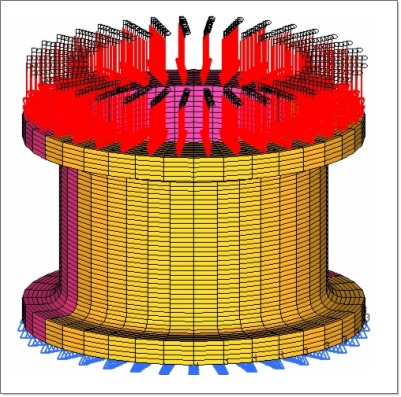
Full model; Elements, material, props and BCs
The following exercises are included:
| 1. | Analysis with the full model |
| • | Retrieving the HyperMesh database file |
| • | Viewing the results in HyperView |
| 2. | Analysis with a small portion of the full model with axi-symmetry boundary conditions |
| • | Setting up the axi-symmetric structure in HyperMesh |
| • | Viewing the results in HyperView |
Exercise 1: Analysis with the Full Model
Step 1: Launch HyperMesh and set the OptiStruct User Profile
| 2. | A User Profiles Graphic User Interface (GUI) appears, select OptiStruct. |
| 3. | Click OK. This loads the user profile. It includes the appropriate template, macro menu, and import reader, paring down the functionality of HyperMesh to what is relevant for generating models for OptiStruct. |
Step 2: Open the File axi-symmetry_full_geometry.hm
| 1. | Click File > Open. An Open Model browser window opens. |
| Note: | If HyperMesh Desktop was launched, use: File > Open > Model. |
|
| 2. | Select the axi-symmetry_full_geometry.hm file you saved to your working directory from the optistruct.zip file. Refer to Accessing the Model Files. |
The axi-symmetry_full_geometry.hm database is loaded into the current HyperMesh session, replacing any existing data. The database only contains geometric data.
You will find that the structural model has already been set up with the necessary elements, boundary conditions, property, and material data so that it is ready to solve. Pressure load is applied on the top face of the geometry and constraints are defined at the bottom face. Note that the model is symmetrical about the z-axis and that loads and boundary conditions are symmetrical about the same axis as well. These represent the conditions necessary for modeling axi-symmetry problems. First, obtain the result for the full model and then you model a small part of the model with boundary conditions suitable to enforce the axi-symmetric behavior. Finally, you compare the results of the axi-symmetric model with the full model results.
Solving the job and post-processing the results is explained in the next sectioin.
Step 3: Submitting the Job
| 1. | From the Analysis page, enter the OptiStruct panel. |
| 2. | Click save as following the input file: field. A Save As browser window appears. |
| 3. | Select the directory where you would like to write the OptiStruct model file and enter the name for the model, axi-symmetry_full_geometry.fem, in the File name: field. The .fem file name extension is the suggested extension for OptiStruct input decks. |
The name and location of the axi-symmetry_full_geometry.fem file displays in the input file: field.
| 5. | Set the export options: toggle to all. |
| 6. | Set the run options: toggle to analysis. |
| 7. | Set the memory options: toggle to memory default. |
| 8. | Click OptiStruct. This launches the OptiStruct job. A command window opens up and indicates the start of the OptiStruct run. |
If the job is successful, new results files can be seen in the directory where the OptiStruct model file was written. The axi-symmetry_full_geometry.out file is a good place to look for error messages that will help to debug the input deck if any errors are present.
Step 4: Viewing the Results
When the message Process completed successfully is received in the command window, click HyperView in the OptiStruct panel of HyperMesh.
The HyperView Graphic User Interface (GUI) window opens and the results automatically get loaded into HyperView. A message window appears to inform about the successful loading of the model and result files in to HyperView. Close the message window.
Displacement and stress results are output for each subcase to the axi-symmetry_full_geometry.h3d file from OptiStruct. This section describes how to view those results in HyperView.
Step 5: View the displacements of the structure
It is helpful to view the deformations of the model first, to determine if the boundary conditions have been defined correctly and also to see if the model is deforming as expected.
| 1. | Set the Animation mode to Linear. |
| 2. | Click the Contour icon  on the toolbar. on the toolbar. |
| 3. | Select the first pull-down menu below Result Type and select Displacement [v]. |
| 4. | Select the second pull-down menu below Result Type and select Mag. |

| 5. | Click Apply to display the displacement contour. |
To view the displacement variation across the thickness, one half of the structure can be masked.
| 6. | Expand the Components folder in the Results browser. |
| 7. | Click the elements icon in front of the component bottom_half to mask the component from display. |
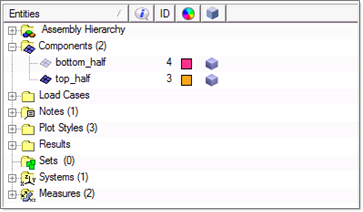
| 8. | Click XZ Left Plane View  to display the Left view. to display the Left view. |
| 9. | The following figure shows the displacements through the thickness. |
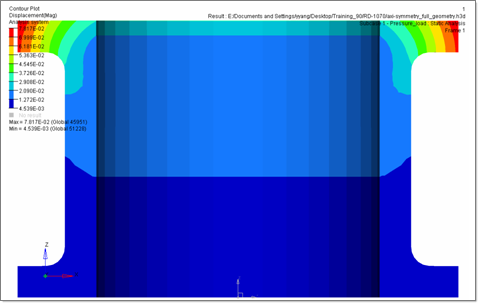
Exercise 2: Analysis with a Small Portion of the Full Model with Axi-symmetry Boundary Conditions
Setting up the New Analysis
Return to HyperMesh to delete the all the elements, except for a small portion and to set up the axi-symmetry boundary conditions.
Before proceeding to the next section, let’s look at the criteria for modeling an axi-symmetry problem. Note that even if the geometry is symmetrical about an axis, if any of the loads or boundary conditions are not symmetrical about the same axis, then it cannot be modeled as an axi-symmetry model. Therefore, the models shown below are examples that cannot be modeled as axi-symmetry models.
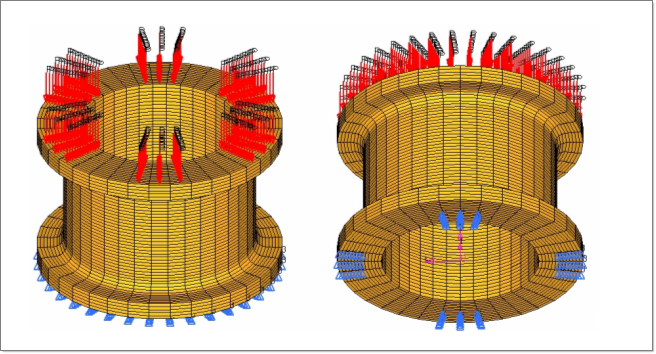
| Non axi-symmetric loads | Non axi-symmetric boundary conditions |
Step 1: Setup the axi-symmetry model
| 1. | Click  to enter the Delete panel, or click F2. to enter the Delete panel, or click F2. |
| 2. | Make sure the entity selection switch is set to elems. |
| 3. | Click the yellow button elems to open the extended entity selection window and select by sets. |
| 4. | Click in the check box in front of SetA. A check mark appears before SetA to indicate that it is selected. |
| 5. | Click select. The selected elements are highlighted. |
| 6. | Click delete entity to delete the selected elements. |
| 7. | Click return to exit the Delete panel. |
Use the retained portion to model the axi-symmetric model with suitable boundary conditions.
Step 2: Apply the additional boundary conditions to model axi-symmetry conditions
The axi-symmetry conditions are applied by constraining all of the nodes from moving in the tangential  direction. This is done by first assigning all of the nodes to a cylindrical coordinate system and then constraining all of them in tangential
direction. This is done by first assigning all of the nodes to a cylindrical coordinate system and then constraining all of them in tangential  degrees of freedom.
degrees of freedom.
| 1. | From the Analysis page, enter the systems panel. |
| 2. | Select the assign radio button. |
| 3. | Make sure the entity selection switch in front of set: is set to nodes. |
| 4. | Click the yellow button nodes to open the extended entity selection window and select all. |
| 5. | Click the yellow button system to activate it and select the red colored system from the graphic window. |
| 6. | Click set displacement. |
The message on the footer bar “The analysis system has been assigned” appears.
All of the nodes in the model are assigned to a cylindrical coordinate system. Note that the z-axis of the cylindrical coordinate system coincides with the axis about which the model is symmetrical. Now, constraining the nodes that are assigned to the cylindrical coordinate system in tangential degrees of freedom enforces the axi-symmetry boundary condition.
Step 3: Create constraints
| 1. | Expand the Load Collectors folder in the Model browser. |
| 2. | Right-click on SPCs and click Make Current to make SPCs the current component, if not already done. |
| 3. | Click BCs > Create > Constraints to open the Constraints panel. |
| 4. | Make sure the entity selection switch is set to nodes. |
| 5. | Click the yellow button nodes to open the extended entity selection window and select all. |
DOFs with a check will be constrained, while dofs without a check will be free.
DOFs 1, 2, and 3 are radial, tangential and translation degrees of freedom.
DoOFs 4, 5, and 6 are radial, tangential and translation rotational degrees of freedom.
| 7. | Click create. This applies these constraints to the selected nodes. |
| 8. | Click return to return to the main menu. |
Step 4: Submitting the Job
| 1. | From the Analysis page, enter the OptiStruct panel. |
| 2. | Solve the job with file name as axi-symmetry_model.fem by following the same steps as explained in the earlier section. |
If the job is successful, new results files can be seen in the directory where the OptiStruct model file was written. The axi-symmetry_model.out file is a good place to look for error messages that will help to debug the input deck if any errors are present.
Step 5: Viewing the Results
Displacement and Stress results are output for each subcase to axi-symmetry_model.h3d file from OptiStruct. Results from the axi-symmetry model should match with the results of the full model. Use load the result file in the previously opened HyperView session to compare the results.
| 1. | Click HyperView to view the results. |
| 2. | Click the Page Layout icon  . . |
| 3. | Select the two window layout  . . |
| 4. | Activate the new window by clicking in the graphic area of the new window. |
| 5. | Click  to open the Load model and results panel. to open the Load model and results panel. |
| 6. | Click the Load model icon  on the toolbar and load the axi-symmetry_model.h3d. This loads the complete path of the selected .h3d file in the field. Also note that the same file path is loaded next to the field Load results. on the toolbar and load the axi-symmetry_model.h3d. This loads the complete path of the selected .h3d file in the field. Also note that the same file path is loaded next to the field Load results. |
| 8. | Click XZ Left Plane View  to display the Left view. to display the Left view. |
| 9. | Click the Contour icon  on the toolbar and contour the displacements. on the toolbar and contour the displacements. |
| 10. | Compare the displacement results of the axi-symmetry model with the result from the full model. The results should match, as shown in the below picture. Similarly, stress and other results will also match. |
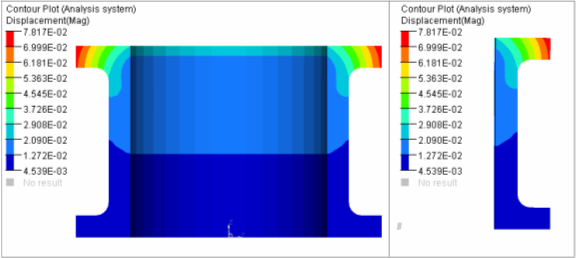
Comparison of displacement results
See Also:
OptiStruct Tutorials














